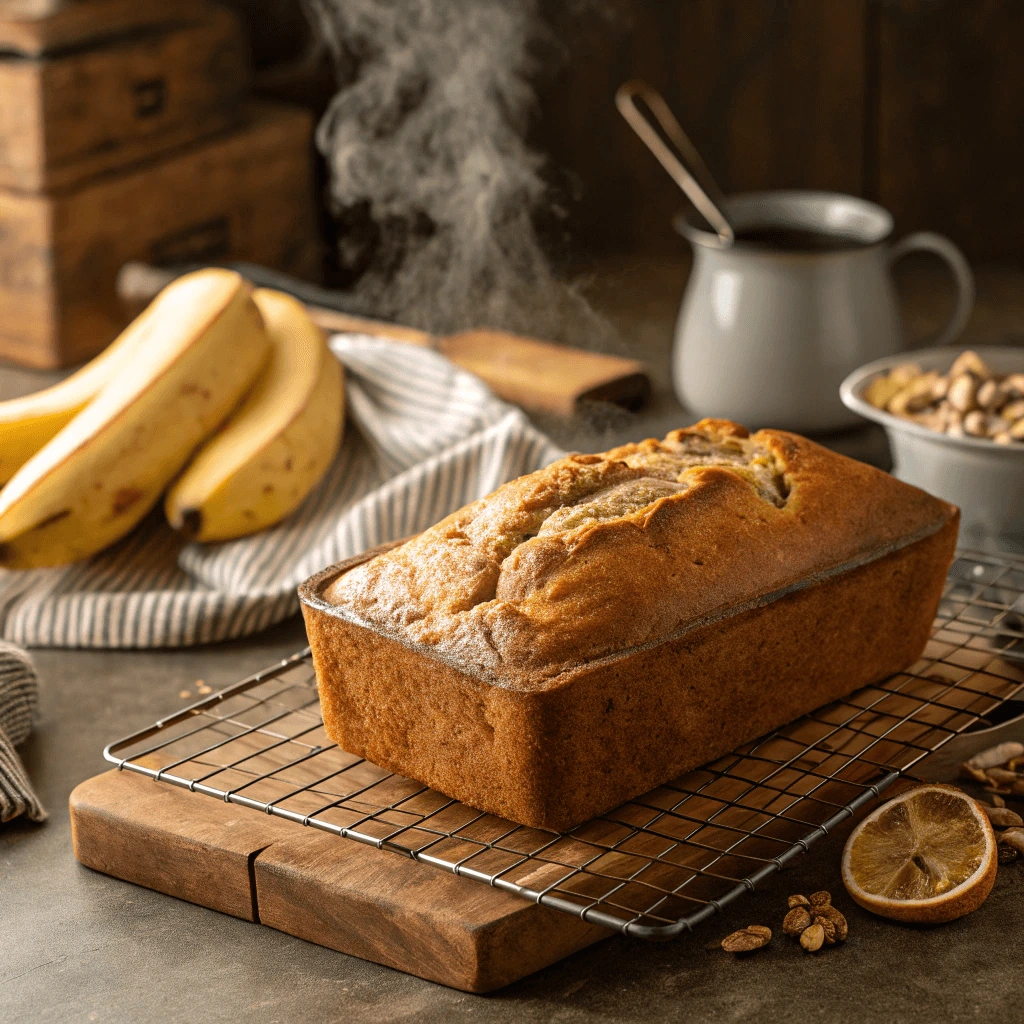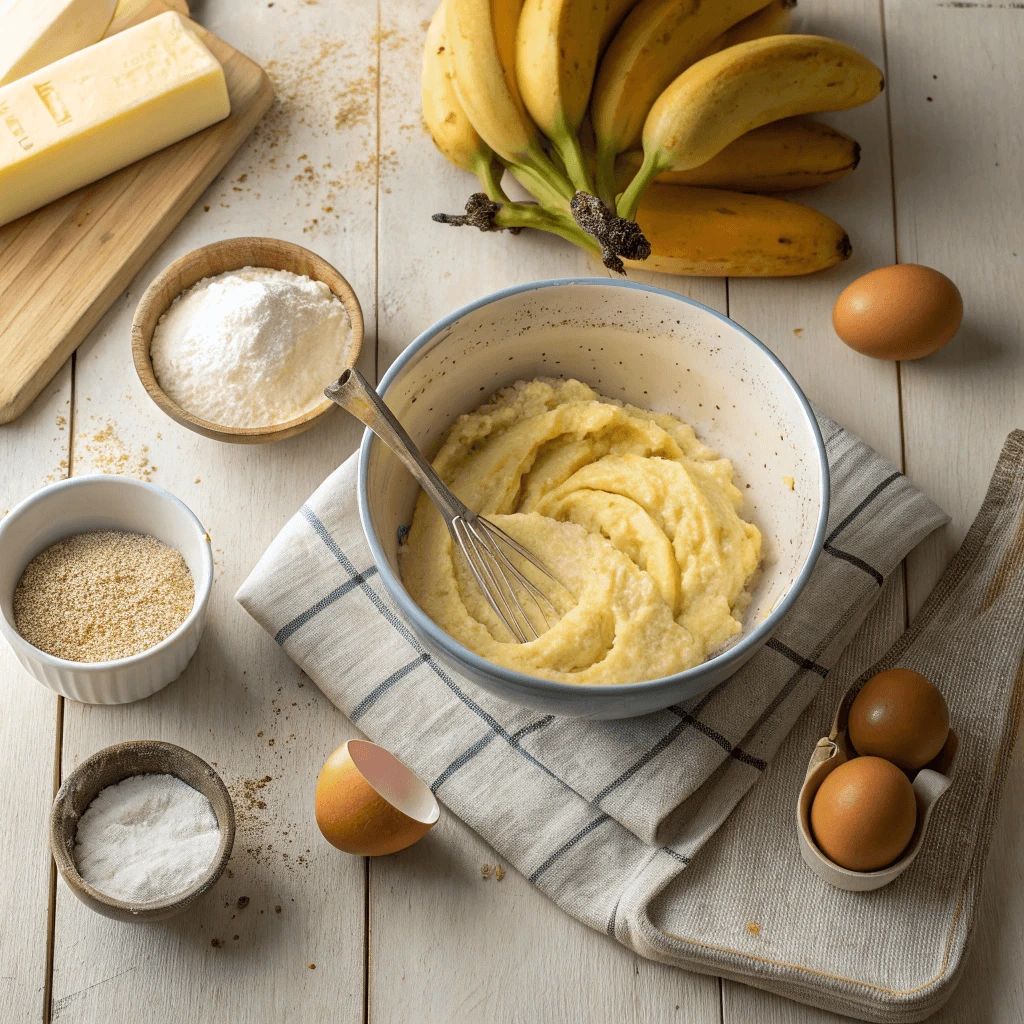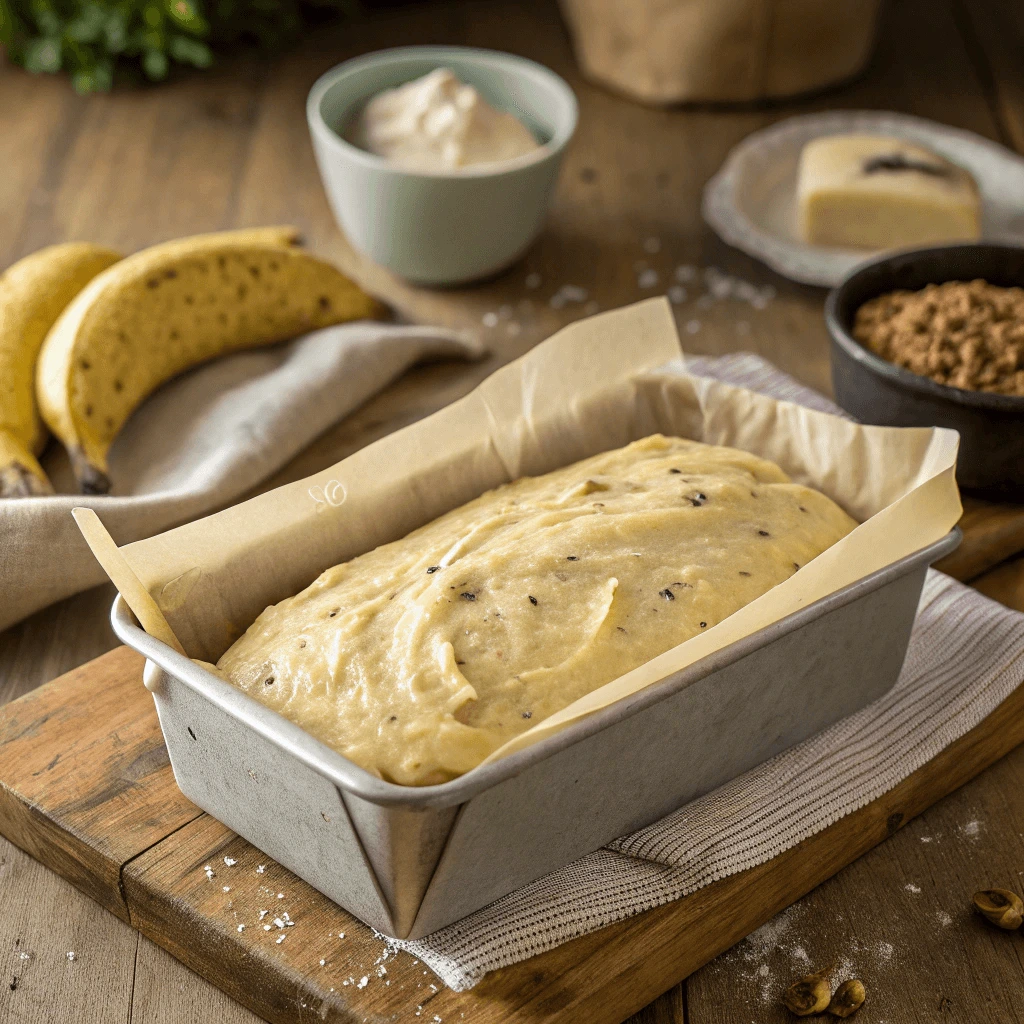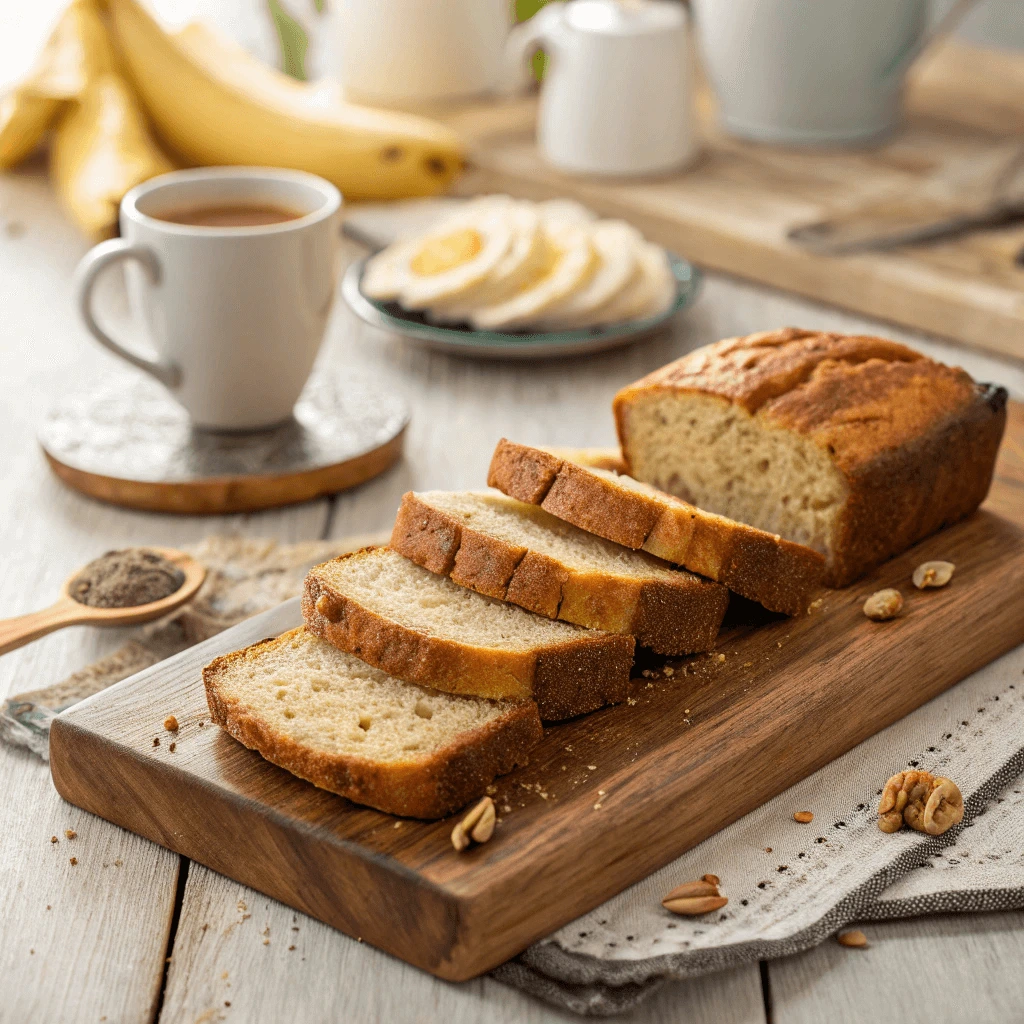There’s nothing quite like the comforting aroma of freshly baked banana bread filling your kitchen. Whether you’re a seasoned baker or just starting out, learning how to bake moist and delicious banana bread at home is easier than you think. With simple ingredients like ripe bananas, flour, and eggs, you can create a soft, flavorful loaf perfect for breakfast, snacks, or dessert. In this post, you’ll discover the key techniques, ingredients, and tips that make this homemade treat truly irresistible. Let’s get baking!
Why Banana Bread Is the Ultimate Homemade Treat

A Classic Use for Overripe Bananas
Why Overripe Bananas Work Best
Overripe bananas aren’t just salvageable—they’re the secret to moist and flavorful banana bread. As bananas ripen, their starches convert to natural sugars. This transformation gives the bread a rich, sweet taste without needing extra sugar. Their soft, mushy texture also blends easily into batter, creating a smoother, more consistent mix.
Flavor and Sweetness Amplified
The brown speckles on banana peels signal peak sweetness. These bananas carry more aroma and deeper banana flavor compared to just-ripe ones. When baked, they infuse the loaf with a natural caramel-like taste that can’t be matched by firm, yellow bananas.
Reduce Waste, Bake Something Great
Instead of tossing overripe bananas, put them to good use. Baking banana bread offers a sustainable, delicious solution to food waste. It transforms a piece of fruit that might be discarded into something your whole household can enjoy.
Using overripe bananas in banana bread isn’t just a tradition—it’s a practical and flavorful choice. So the next time you see dark bananas on your counter, don’t throw them away. Use them to whip up the Best Banana Bread Recipe your kitchen has ever seen.
Comforting Flavors and Moist Texture
Why Banana Bread Feels So Comforting
Banana bread offers more than just a tasty bite—it evokes feelings of warmth, nostalgia, and home. The rich banana aroma that fills the kitchen as it bakes often brings back memories of childhood or cozy weekends. Its soft, sweet, and slightly dense texture gives the kind of comfort few baked goods can match.
Flavor Combinations That Soothe the Senses
Ripe bananas naturally provide a mellow sweetness, which balances perfectly with flavor boosters like vanilla extract and cinnamon. Brown sugar adds a caramel undertone, while a dash of nutmeg deepens the flavor profile. These ingredients combine to create a taste that feels familiar, satisfying, and incredibly homey.
How Moisture Creates the Perfect Bite
Moisture is key to making banana bread irresistible. Ingredients like overripe bananas, butter or oil, and eggs work together to create a tender crumb. Each bite melts in your mouth rather than feeling dry or crumbly. Avoiding overmixing and watching your bake time closely helps lock in that perfect moist texture.
When you combine comforting flavors with just the right amount of moisture, banana bread becomes more than a simple loaf—it becomes a cherished treat. That’s why mastering this balance is essential to baking the Best Banana Bread Recipe at home.
Simple Ingredients That Make Moist and Delicious Banana Bread
Pantry Staples with Purpose
Banana bread doesn’t need complicated ingredients to taste amazing. In fact, its magic lies in simplicity. You can create rich flavor using everyday pantry items—flour, sugar, eggs, baking soda, butter or oil, and ripe bananas. These basics, when combined thoughtfully, build a moist, flavorful loaf without the need for fancy extras.
Each Ingredient Adds Depth
Every element in banana bread serves a flavorful role. Mashed bananas provide sweetness, moisture, and texture. Eggs help bind the ingredients while contributing richness. Butter or oil adds tenderness, keeping the bread from drying out. Sugar doesn’t just sweeten—it also helps the loaf brown beautifully while balancing the banana’s natural acidity.
Flavor Boosters That Make a Difference
Small additions can enhance the flavor without overwhelming it. A splash of vanilla extract brings warmth and aroma. A pinch of salt sharpens the sweetness and ties everything together. Cinnamon or nutmeg adds gentle spice for depth. These simple upgrades make your loaf more memorable.
Essential Ingredients for Moist and Delicious Banana Bread

Ripe Bananas: The Star of the Recipe
Why Ripeness Matters
Ripe bananas aren’t just preferred—they’re essential for making the Best Banana Bread Recipe. As bananas ripen, their natural starches convert to sugar, giving the bread a naturally sweet and rich flavor. A yellow banana with brown spots has the perfect balance of moisture and sweetness for baking.
Texture Benefits from Soft Bananas
When bananas soften, they mash easily and blend smoothly into the batter. This soft texture creates a moist and tender crumb in the finished loaf. Overripe bananas also distribute evenly, ensuring consistent flavor in every slice. The softer the banana, the better it performs in the recipe.
Flavor Depth from Natural Sugars
Fully ripened bananas add caramel-like notes that deepen the flavor of the bread. Unlike artificial sweeteners, the sugars in ripe bananas provide a complex sweetness that pairs beautifully with warm spices like cinnamon and nutmeg. This natural enhancement gives banana bread its signature comforting taste.
Using underripe bananas won’t deliver the same results. Their firmer texture and lower sugar content can lead to a dry loaf with muted flavor. Instead, choose bananas that look overly ripe—soft to the touch with lots of brown spots.
In banana bread, ripe bananas are more than just an ingredient—they’re the flavor foundation. When chosen wisely, they elevate your recipe from good to exceptional.
The Role of Butter, Oil, and Eggs in Moisture
Butter Adds Richness and Flavor
Butter brings more than moisture to banana bread—it enhances the overall flavor. When you cream it with sugar or melt it into the batter, butter contributes a smooth, buttery richness that complements the sweet bananas. It also gives the bread a soft, tender crumb and a golden-brown crust.
Oil Keeps the Bread Tender Longer
While butter adds flavor, oil helps lock in moisture. Neutral oils like canola or vegetable oil are ideal. They stay liquid at room temperature, so your banana bread remains soft and moist for days. Some bakers combine both butter and oil to balance flavor and moisture retention for the Best Banana Bread Recipe.
Eggs Bind and Soften the Batter
Eggs play several roles. They bind the ingredients together, add structure, and provide richness. The proteins in eggs firm up during baking, helping the bread rise without making it dense. At the same time, their fat content contributes to a smooth texture and extra moisture.
To create moist banana bread, use room-temperature eggs, softened butter, or oil for even blending. Skipping or replacing these ingredients carelessly can result in dry or crumbly bread. Choose high-quality ingredients and measure accurately to achieve the perfect balance.
Together, butter, oil, and eggs transform a simple loaf into the soft, moist banana bread your family will love every time.
Enhancing Flavor with Vanilla, Cinnamon & Brown Sugar
Vanilla Adds Warmth and Depth
Vanilla extract enhances banana bread by adding a smooth, aromatic flavor. Just a teaspoon of pure vanilla can elevate the overall taste, rounding out the sweetness of the bananas and adding a comforting warmth. Skip artificial vanilla—real vanilla extract makes a noticeable difference in the Best Banana Bread Recipe.
Cinnamon Brings a Cozy Spice Note
Cinnamon pairs beautifully with ripe bananas. Its warm, spicy notes create a cozy flavor profile that makes each bite more inviting. A half to full teaspoon of ground cinnamon gives the bread a subtle complexity without overpowering the banana flavor. For extra spice, you can even add a pinch of nutmeg or allspice.
Brown Sugar Creates Caramel Sweetness
Unlike white sugar, brown sugar contains molasses, which adds a hint of caramel flavor and additional moisture to the batter. Using light or dark brown sugar in part—or in full—deepens the bread’s flavor and gives it a richer texture. It also helps create a beautifully golden crust during baking.
To maximize flavor, mix these ingredients thoroughly into your wet mixture. Don’t just rely on bananas for sweetness—layering flavor with vanilla, cinnamon, and brown sugar makes your banana bread memorable. These three ingredients work together to transform a simple loaf into something that tastes like it came from a bakery.
Step-by-Step Instructions: How to Bake Moist and Delicious Banana Bread

How to Mix the Batter the Right Way
Start with the Wet Ingredients
Begin by mashing the ripe bananas in a large bowl until smooth. Add the eggs, oil or melted butter, vanilla extract, and brown sugar. Whisk these ingredients together until the mixture looks well-blended and creamy. Mixing the wet ingredients thoroughly ensures an even texture and flavor in the final loaf.
Combine Dry Ingredients Separately
In a separate bowl, whisk together the flour, baking soda, salt, and cinnamon. This step helps distribute the leavening and spices evenly, preventing bitter pockets or uneven rise. Avoid skipping this step—adding dry ingredients directly to the wet bowl can result in clumps and uneven mixing.
Mix Gently—Don’t Overdo It
Pour the dry ingredients into the wet mixture gradually. Use a spatula or spoon to fold the batter gently. Stir until the flour disappears—no more. Overmixing activates the gluten in the flour, which leads to dense, rubbery banana bread instead of a tender, moist loaf. You should still see a few small lumps in the batter when you stop stirring.
Proper mixing balances structure and softness in the Best Banana Bread Recipe. By handling the batter gently and combining ingredients in stages, you create a light, fluffy texture without sacrificing moisture or flavor.
Choosing the Right Loaf Pan and Greasing It Well
Select the Correct Size and Material
The loaf pan you use affects the texture, baking time, and appearance of your banana bread. For the best results, choose a standard 9×5-inch metal or glass loaf pan. Metal pans conduct heat more evenly and promote better browning, while glass pans may require a few extra minutes of baking. Avoid oversized pans, as they spread the batter too thin and dry it out quickly.
Understand Pan Color and Bake Time
Light-colored pans reflect heat, resulting in a lighter crust. Darker pans absorb more heat and can cause the edges to overbrown before the center cooks through. If using a dark pan, reduce the oven temperature by 25°F and monitor closely during baking.
Grease Thoroughly to Prevent Sticking
Always grease the loaf pan, even if it’s non-stick. Use butter or a neutral oil to coat the bottom and sides of the pan. For extra protection, dust the greased pan lightly with flour or line it with parchment paper. This step ensures your banana bread slides out smoothly and retains its beautiful shape.
Proper pan selection and greasing set the foundation for the Best Banana Bread Recipe. Taking the time to prepare the pan correctly leads to a soft interior, golden crust, and flawless release every time.
Ideal Baking Time and Oven Temperature
Preheat for Precision
Always preheat your oven before placing the banana bread inside. A consistent temperature from the start ensures even baking and prevents undercooked centers. Set your oven to 350°F (175°C) for standard banana bread recipes.
Use the Right Rack Position
Position your oven rack in the center to allow for even air circulation. Placing the loaf too close to the top or bottom can lead to uneven browning or a scorched crust. The center rack provides the most balanced heat for a perfectly golden loaf.
Baking Time Guidelines
Most banana bread loaves bake in 55 to 65 minutes. However, exact time can vary depending on the pan material, batter moisture, and oven calibration. Begin checking around the 50-minute mark. Gently insert a toothpick or skewer into the center. If it comes out clean or with just a few moist crumbs, the loaf is done.
Avoid Overbaking
Overbaking leads to dry, crumbly bread. If the top begins to brown too quickly, loosely tent it with foil for the last 10 to 15 minutes. This helps the interior finish baking without burning the crust.
Managing the correct bake time and temperature ensures your loaf is soft, evenly cooked, and rich with banana flavor—key qualities of any moist and delicious banana bread recipe.
Popular Variations of Moist and Delicious Banana Bread
Banana Nut Bread with Walnuts or Pecans
Why Nuts Make a Difference
Walnuts and pecans introduce a satisfying crunch and nutty richness that elevate the flavor and texture of banana bread. These nuts contrast the softness of the loaf, making each bite more interesting. You can toast the nuts before adding them to enhance their aroma and depth of flavor.
Choosing Between Walnuts and Pecans
Walnuts offer a slightly bitter, earthy taste that pairs beautifully with the sweetness of ripe bananas. Pecans, on the other hand, bring a sweeter, buttery note. Choose based on your flavor preference or mix both for a well-rounded, nutty bite. For the best results, use 1/2 to 3/4 cup of chopped nuts per loaf.
How to Add Nuts the Right Way
Fold chopped nuts gently into the batter just before pouring it into the loaf pan. This keeps them evenly distributed without sinking to the bottom. You can also sprinkle a few on top for added crunch and visual appeal. Avoid overmixing the batter at this stage, as it may affect the bread’s rise and texture.
Banana nut bread adds rustic charm and wholesome appeal to the classic recipe. The combination of ripe bananas and crunchy nuts delivers the perfect balance of moist crumb and hearty texture—ideal for breakfast, snacking, or gifting.
Chocolate Chip Banana Bread for a Sweet Twist
Why Add Chocolate Chips?
Chocolate chips bring a sweet, melty contrast to the moist texture of banana bread. As they bake, the chips melt slightly and create rich pockets of flavor throughout the loaf. This twist appeals especially to kids and dessert lovers looking for something more indulgent than the classic recipe.
Best Chocolate Chips to Use
You can use semi-sweet, milk, or dark chocolate chips depending on how rich or sweet you want your loaf to taste. Semi-sweet chips strike a nice balance, while dark chocolate adds intensity. Mini chocolate chips distribute more evenly throughout the batter, but regular chips work just as well for bold bites of chocolate.
Tips for Incorporating Chips Properly
To prevent chocolate chips from sinking, toss them lightly in a bit of flour before folding them into the batter. Use around ½ to ¾ cup of chips per loaf. Fold them in gently after mixing the wet and dry ingredients to avoid overmixing, which can make the loaf dense. You can also sprinkle a few on top of the batter before baking for an extra chocolaty finish.
Adding chocolate chips transforms banana bread into a more decadent treat while maintaining its moist crumb. Whether served warm or at room temperature, this version delivers the ultimate comfort with every slice.
Healthy Banana Bread with Whole Wheat and Less Sugar
Why Choose Whole Wheat Flour?
Whole wheat flour adds more fiber, vitamins, and minerals compared to all-purpose flour. Using whole wheat gives your banana bread a nuttier flavor and a denser texture, which many find satisfying and wholesome. You can substitute all-purpose flour with whole wheat flour completely or start by replacing half to retain a lighter crumb.
Reducing Sugar Without Sacrificing Taste
Banana bread naturally tastes sweet thanks to ripe bananas. You can lower the amount of added sugar in your recipe by 25-50% without losing flavor. Consider using alternatives like coconut sugar, honey, or maple syrup to add natural sweetness and subtle flavor notes. These alternatives often contain more nutrients than regular granulated sugar.
Balancing Moisture and Texture
Because whole wheat flour absorbs more liquid, you may need to add a bit more moisture. Incorporate extra bananas, applesauce, or a splash of milk to keep the bread moist. Reducing sugar slightly can also make the texture denser, so balancing wet and dry ingredients is key.
Tips for Baking Healthy Banana Bread
Mix ingredients gently to avoid toughening the bread. Use ripe bananas to enhance sweetness naturally. Adding nuts or seeds can boost the nutritional value and add crunch. Finally, monitor the baking time closely, as whole wheat versions may bake faster or slower than traditional recipes.
Making healthy banana bread with whole wheat and less sugar lets you enjoy a delicious treat while supporting your wellness goals—perfect for breakfast or guilt-free snacking.
Storage and Serving Tips for Moist and Delicious Banana Bread
How to Store Banana Bread to Keep It Fresh
Short-Term Storage: Room Temperature
For fresh banana bread, store it at room temperature if you plan to eat it within two to three days. Wrap the bread tightly in plastic wrap or aluminum foil to lock in moisture and prevent it from drying out. Alternatively, place the bread in an airtight container or resealable plastic bag. Keep it away from direct sunlight and heat sources to maintain its soft texture.
Refrigeration for Longer Freshness
If you want to extend banana bread’s shelf life up to a week, refrigerate it. Wrap the loaf tightly in plastic wrap or foil, then place it in an airtight container or zip-top bag. Refrigeration slows down mold growth but can dry out the bread, so reheat slices gently before serving to restore moisture and softness.
Avoiding Common Storage Mistakes
Don’t leave banana bread exposed to air, as it dries out quickly and becomes stale. Avoid storing it in a paper bag unless you plan to eat it immediately. Also, keep it separate from strong-smelling foods in the fridge or pantry to prevent flavor transfer.
Serving Tips After Storage
To enjoy banana bread as if it were freshly baked, warm slices in a microwave or toaster oven for 10-20 seconds. This simple step revives the bread’s softness and enhances its flavor.
Proper storage preserves your banana bread’s moist, flavorful qualities, so you can savor every slice, fresh or later.
Reheating Moist Banana Bread Without Drying It Out
Why Proper Reheating Matters
Banana bread can lose its moist texture if reheated improperly. Heat can dry it out quickly, turning your delicious loaf into a tough, crumbly snack. Using the right reheating methods preserves the soft, flavorful qualities you love.
Microwave Method: Quick and Moist
The microwave offers a fast way to warm banana bread, but you must take care to avoid overcooking. Place a slice on a microwave-safe plate, then cover it loosely with a damp paper towel. Heat it for 10 to 15 seconds, then check its temperature. Repeat briefly if needed. The moist towel creates steam, helping keep the bread soft.
Oven or Toaster Oven Method: Even Heating
For a more evenly warmed slice, use an oven or toaster oven. Preheat the oven to 325°F (160°C). Wrap the banana bread slice loosely in aluminum foil to trap moisture. Warm it for about 10 to 15 minutes. This method heats the bread gently without drying the edges, maintaining that tender crumb.
Additional Tips for Best Results
Avoid reheating the entire loaf multiple times, as this accelerates drying. Instead, slice the bread beforehand and reheat only what you plan to eat. Adding a small pat of butter or a drizzle of honey after reheating can enhance flavor and add moisture.
How to Freeze and Thaw Moist Banana Bread Slices for Later Enjoyment
Why Freeze Banana Bread?
Freezing banana bread allows you to preserve its freshness and flavor for weeks. It’s a great way to avoid waste and enjoy homemade bread whenever you want without baking from scratch every time.
Preparing Banana Bread for Freezing
Start by slicing the banana bread into individual portions. Slicing before freezing helps you thaw only what you need, reducing waste. Wrap each slice tightly with plastic wrap to prevent freezer burn and maintain moisture. After wrapping, place the slices in an airtight freezer-safe bag or container. Remove as much air as possible before sealing to keep the bread fresh longer.
Freezing Tips for Best Results
Label the bag or container with the date of freezing. Banana bread slices usually stay fresh for up to 3 months in the freezer. Avoid freezing the whole loaf at once because it takes longer to thaw and can affect texture.
How to Thaw Frozen Banana Bread
When ready to eat, thaw slices by leaving them at room temperature for about 30 to 60 minutes. If you’re in a hurry, unwrap the slice and warm it in the microwave for 15 to 20 seconds. For a crispier texture, you can also reheat slices in a toaster oven at 325°F (160°C) for 5 to 7 minutes.
Maintaining Moisture and Flavor
To keep the banana bread moist after thawing, avoid overheating it. Adding a little butter or cream cheese on top can enhance the flavor and texture. Proper freezing and thawing ensure you enjoy the delicious taste and softness of banana bread anytime.
Conclusion
Mastering the art of moist and delicious banana bread at home is easier than you think. Using ripe bananas, the right balance of butter or oil, and gentle mixing techniques ensures every loaf stays soft and flavorful. Whether you prefer classic banana bread or exciting variations like nutty or chocolate chip versions, following these tips guarantees a moist and delicious banana bread every time. With proper storage and reheating, you can enjoy your homemade moist and delicious banana bread fresh for days. Start baking today and treat yourself to this timeless comfort food!
